- Bees
- Chickens
- Cows
- Deer
- Donkeys
- Elephants
- Frogs
- Geese
- Horses
- Lobsters
- Pigs
- Rabbits
- Rats
- Seals
- Sheep
- Turkeys
Lobsters
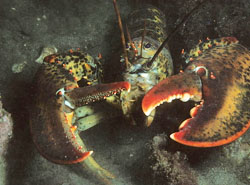
Lobsters are invertebrates, members of the Class Crustacea of the Phylum Arthropoda. This class includes animals without backbones and with hard shells like crab, shrimp, crayfish, water fleas and wood lice.
A male lobster is called a cock and a female a hen or chicken (when she weighs about 1 pound).
There are two kinds of lobsters, the "true" lobster (also called American lobster) and the spiny lobster. The true lobster has claws on the first four legs, lacking in the spiny lobster. The spiny lobster has a pair of horns above the eyes, lacking in the true lobster. Spiny lobsters also have two large cream-colored spots on the top of the second segment of the tail.

Small lobsters, less than 1.5 inches carapace (carapace length is measured from the rear of the eye socket to the rear of the main body shell), hide in and about sea weeds and rocky habitat that provide enough food and shelter from predators. Adolescent lobsters, 1.5 to 3.5 inches carapace, are found in coastal habitats and offshore areas. Adult lobsters inhabit deeper waters, but return seasonally to shallow warmer waters. Spiny lobsters inhabit tropical and subtropical waters of the Atlantic Ocean, Caribbean Sea and Gulf of Mexico.
Lobster can have many different colors, including blue-green, blue, red, yellow, red-orange and white. Some lobsters come in two colors, having half of their shell one color and the other half another.
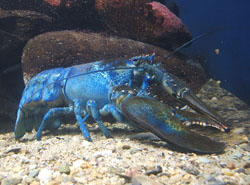
Lobsters grow by molting, or shedding their shells. Before they shed the old shell, they will form a thin one underneath. When molting, they secrete enzymes that soften the shell and connective joints. Lobsters will then struggle out of their old shell while simultaneously absorbing water which expands their body size. This process takes about 15 minutes. Each time they molt, they will increase their size about 20%.
After molting, lobsters will eat voraciously. They often eat their old shell which will replenish the lost calcium and speed up the hardening of the new shell. It takes about 6 to 8 weeks before their new shell is hard enough for lobsters to be able to protect themselves against their natural enemies. While they are soft and fragile, lobsters will bury themselves in the mud or hide under rocks.
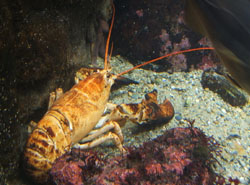
A young, immature lobster (first 5-7 years) will molt about 25 times a year. An adult male lobster molts twice a year and an adult female lobster once a year, usually in the summer. When lobsters get older, they will molt only once every 3-4 years.
The only way to gauge the exact age of a lobster would be by their shell. However, since lobsters shed their shells so often, it is impossible to determine their age. Knowledge of body size at age makes scientists believe that lobsters can attain a maximum age of 100 years. The normal life span is about 15 years. Lobsters can grow to be 3 feet long in overall body length.
To determine the gender of a lobster, you have to look at the swimmerets, the small feathery appendages on the underside of the tail. The first pair of swimmerets closest to the body are hard and bony on a male and soft and feathery on a female. Only the female has a small shield between the second pair of walking legs, which is the sperm receptacle where she stores the sperm after mating until she lays her eggs. The female also has a wider tail, needed to be able to carry all her eggs.
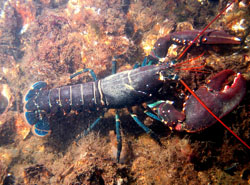
Female lobsters mate primarily when they are in the soft-shell state, right after molting. They can carry live sperm for up to two years until they decide to fertilize their eggs. A 1 pound female will carry about 8,000 eggs. A 9 pound female may carry more than 100,000 eggs. Freshly laid eggs are the size of the head of a pin and are attached to the swimmerets under their mothers tail for almost a year with a glue-like substance. During that year the larvae will molt about six times while still in the egg.
When the eggs are ready to hatch, the mother will shake them out of their shell, releasing them as larvae. The larvae will float to the surface for 4 to 6 weeks. At the surface, they are easy prey for sea birds, fish and other enemies. Less than 0.1% of the larvae will survive, settle to the bottom and develop as baby lobsters.
Like dolphins, lobsters use complicated signals to establish social relationships. They sometimes walk hand-in-hand, the old leading the young.
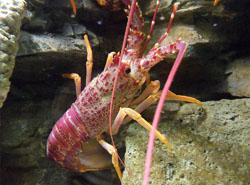
Lobsters usually hunt for food at night. They eat fish, crabs, clams, snails, sea stars, mussels and sea urchins. By nature, lobsters are not cannibalistic, except when held in crowded conditions.
Lobsters chew their food in their stomach, which is very close to their mouth, between three grinding surfaces that look like molar teeth called the "gastric mill".
To escape from enemies, lobsters swim backwards by flipping their tail.
The lobster's body has 19 parts, each covered by a section of the shell. The shell is thin and soft where the parts join, so lobsters can bend their body and move about.
Lobsters breathe through gills located beneath the shell on both sides of their thorax (center part).
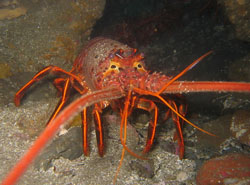
Lobsters eyes are compound eyes, consisting of hundreds of lenses joined together on the ends of pair of jointed organs called stalks. The four small antennae on the front of their heads are used to "smell" their food or chemicals in the water. The tiny sensory hairs along their legs are used to "taste" their food. Lobsters keep their antennae and eye stalks moving constantly to search for food and to watch for enemies.
True lobsters have two very powerful claws. One claw is sharp and used for cutting, the other is bony and used for crushing. Lobsters that have their heavy ("crusher") claw on the right are considered "right-handed" and the others are "left-handed". Some lobsters are ambidextrous, they usually favor the claw that is the largest.
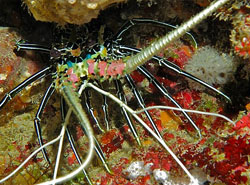
Lobsters can lose claws, legs, eyes and antennae through accident or self-defense, but are able to regenerate them. Lobsters often fight with other lobsters for territory. If another lobster seizes their claw, they may drop their claw to escape. Sometimes, the more aggressive lobster will tear the claw of the opponent off. A lobster with a claw missing is called a cull. It takes about 3 to 4 molt cycles for the claw to grow back to full size.
Lobsters have a sophisticated nervous system that allow them to sense actions that will cause them harm and feel pain. Lobsters don't have an autonomic nervous system that puts them into a state of shock when they are harmed. For this reason, they will feel pain until their nervous system is completely destroyed.



